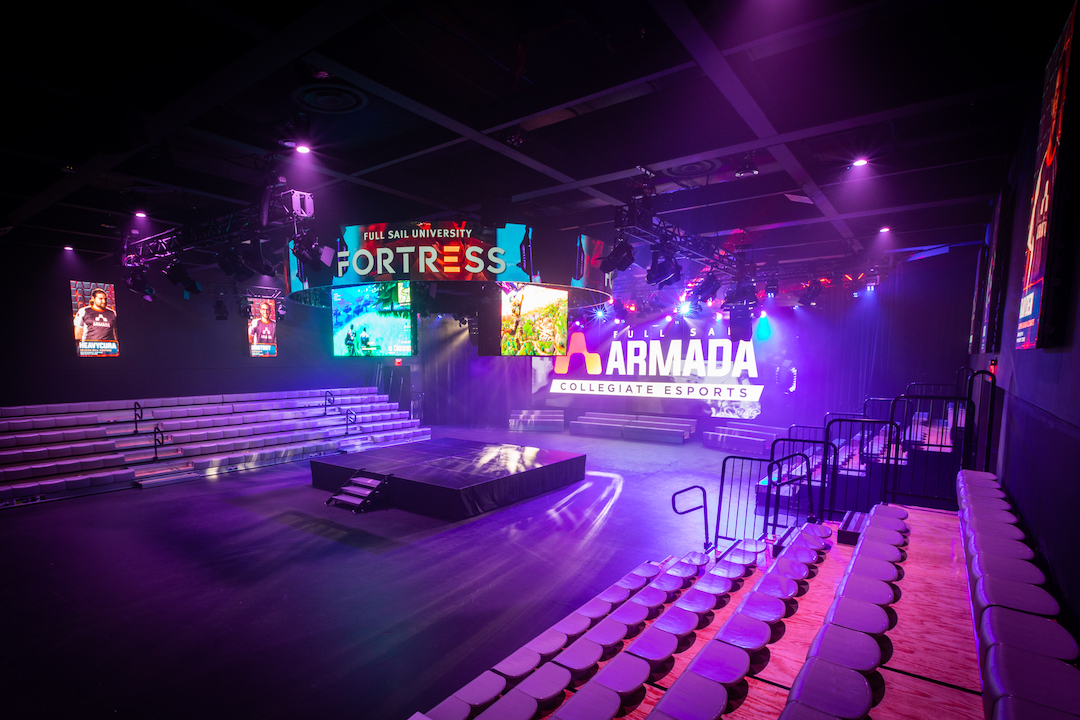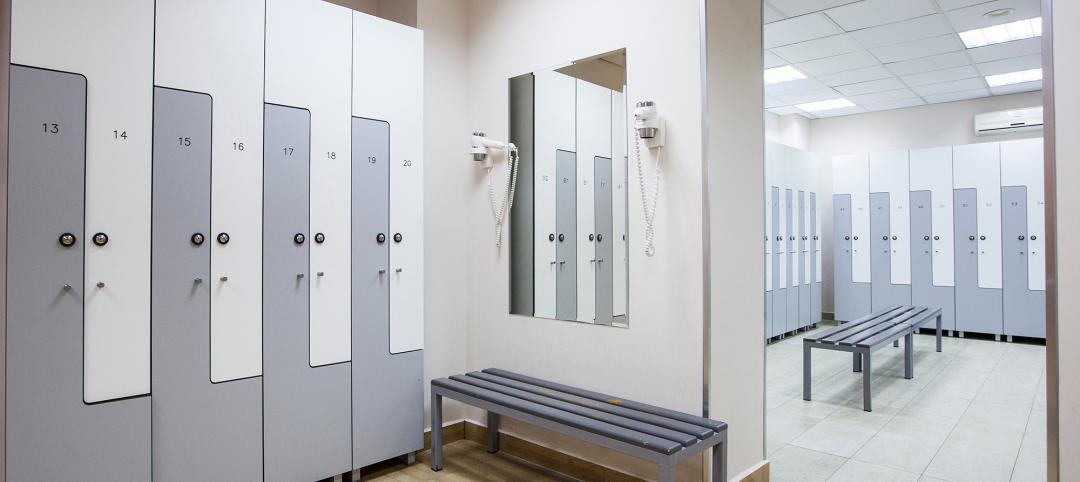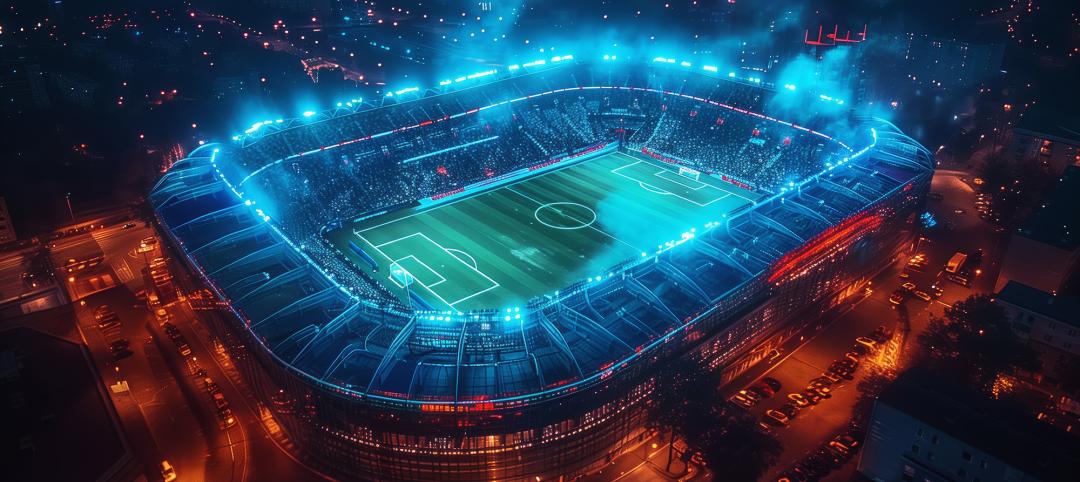The success and popularity of eSports is no longer a surprise to anyone. Purpose-built eSports stadiums are popping up both around the country and the world, hosting events with audiences and prize pools pushing well into the millions.
But now the eSports rocket ship is continuing its journey through the stratosphere, pushing ahead on another front: the college campus. In 2018, Ashland University became the first school in the country to offer scholarships (up to $4,000) for competitive gaming. Other colleges quickly followed suit, and there are now over 60 colleges in the United States offering scholarships in a variety of different games. Robert Morris University offers a scholarship for the game League of Legends that totals $76,000 over a four-year period (50% tuition and 50% room and board per year), rivaling scholarships offered for more traditional sports.
With money like that being thrown around, it’s clear video games are no longer just a hobby; eSports have become a very real and very unique recruiting tool, especially among smaller schools that can’t compete with D-I schools in sports like football and basketball.
See Also: Gamers paradise: The rise of eSports arenas
“The smaller D-II, D-III, and Ivy League schools now have an opportunity to compete on a larger scale and are really embracing eSports,” said Benedict Dubbs, Jr. AIA, LEED A.P., Principal, Murray Associates Architects. “Where else can ‘David beat Goliath’ anywhere in the world without a road trip?”
But in order for David to beat Goliath, they need an arena to fight in. Which is why small colleges such as Harrisburg University of Science and Technology (HU) and Full Sail University have taken it upon themselves to create dedicated eSports arenas and facilities for their student eSports athletes.
HU’s eSports Training Arena
The Storm, HU’s competitive eSports team, recently received a new training facility courtesy of Murray Associates Architects. The architect took a vacant dance studio in the Whitaker Center for Science and the Arts and turned it into HU’s eSports Training Arena.
The 2,460-gsf facility features 24 gaming rigs, a coaching suite, and a student lounge, all designed to enhance the team’s coaching and player collaboration, interactions, and skill development. Flexibility was also a main design focus for the space. Some competitive games are played 1 vs 1, while others pit larger teams against each other. Different games require different set ups, and the relatively small 2,400-sf space needed to be able to accommodate them all.
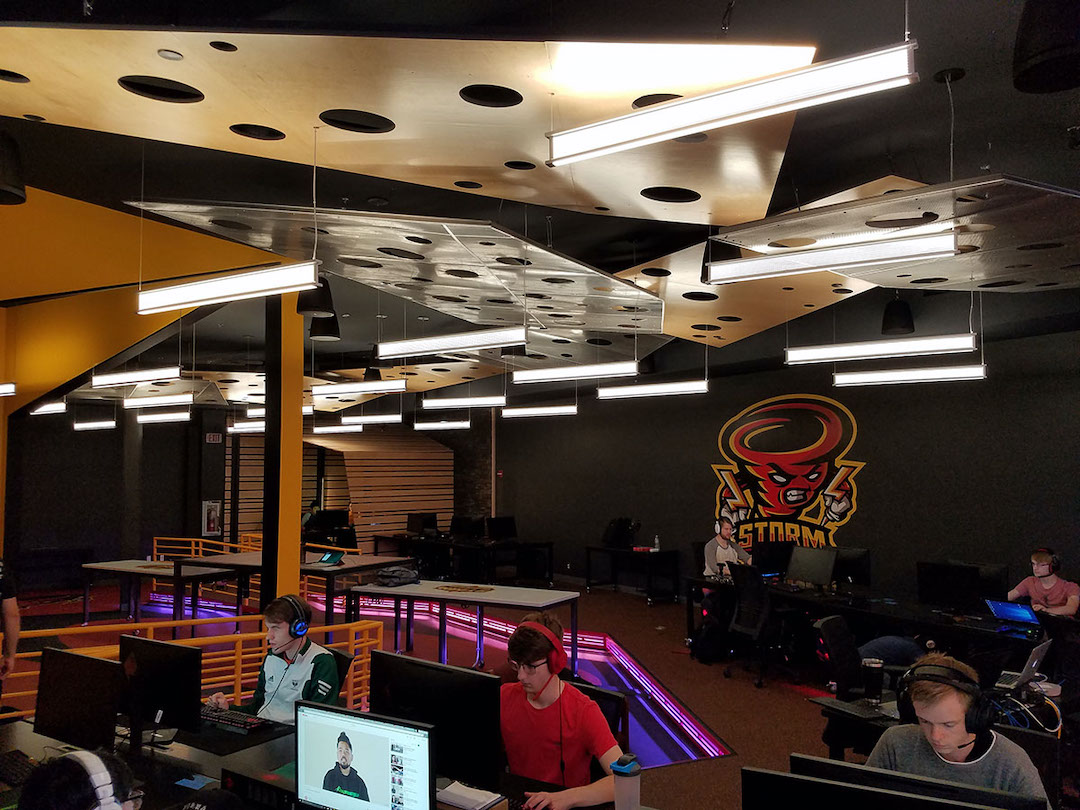 Photo courtesy HU.
Photo courtesy HU.
The entirety of the arena’s power and data cabling runs beneath a custom-designed raised floor with 35 grommets that open access panels. “This design element allows HU to rearrange the gaming stations, pull cable, and quickly rearrange the entire training arena,” said Dubbs. “The concealed cabling is also a safety solution; students can move freely about the space without any trip hazards.”
In fact, the only static power and data in the entire arena was installed in the center core island, or “bullpen,” which is hardwired to the sides of the tables. The bullpen supports team meetings, strategy sessions, socializing, dinners, and other collaborative activities, so having access to technology was vital.
 Photo courtesy HU.
Photo courtesy HU.
The eSports Training Facility differs from more commercial eSports arenas in that it is for players and coaches only. HU Storm matches are viewed in an auditorium in another part of the Whitaker Center for Science and the Arts, meaning everything in the space is designed to help the Storm master their skills; you won’t find branded food and beverage options, a stage for the eSports athletes to play on, or other spectator-focused amenities like premium seating options.
Another lesser-known college, however, has decided to use commercial eSports stadiums as a template to create the largest on-campus collegiate eSports arena in the country.
The Fortress eSports arena at Full Sail University
The Fortress, Full Sail University’s new $6 million eSports arena, is an 11,200-sf space that can accommodate 100 eSports athletes and over 500 live spectators simultaneously. Designed by Blackenship Architects, the arena, much like HU’s Training Facility, was built to be as flexible as possible in order to support any size eSports event. Unlike HU’s space, however, The Fortress was designed not only to be at the forefront of eSports facilities for the college’s athletes, but for spectators as well.
As such, The Fortress features 10 million pixels of LED wall, a concert level PA system, modular wood beam ceilings, live streaming equipment, dynamic sound and lighting solutions, the latest generation live video equipment by Ross Video, Sony video monitors and cameras, large high-resolution LED screens by Absen, multi-zone loudspeaker systems by L-Acoustics, media servers by Green Hippo, and high-bandwidth dedicated internet connectivity. All of this technology combines to create an “intense spectator experience,” according to Stella Posada, Sr. VP of Image & Design at Full Sail University. “We knew we wanted to provide the best eSports experience for both competitor and viewer alike, so it was a priority that we collaborated with thought leaders throughout our various internal teams,” Posada said.
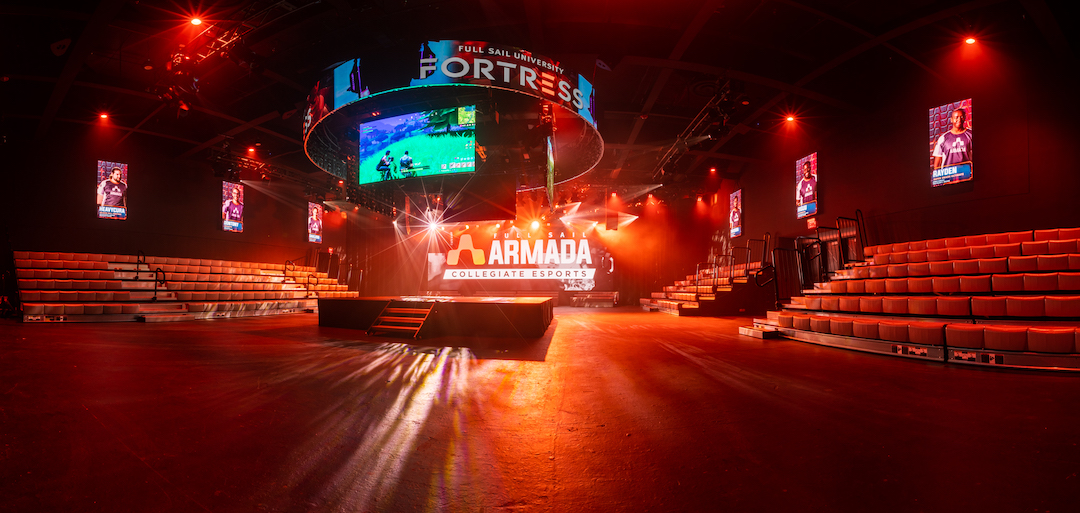 Photo courtesy Full Sail University.
Photo courtesy Full Sail University.
And while Full Sail University approached the project using commercial eSports venues as inspiration, The Fortress also fulfills a unique roll for the school’s students. Each live event hosted in the space provides students the opportunity to hone their skills in areas beyond eSports, such as show production, film, graphic design, gaming, and entertainment and business.
Overall, the school approached the design of The Fortress with three main goals:
– Create a leading-edge facility to support its collegiate level eSports team, Armada
– Create a space to serve as an experiential educational learning environment
– Create a space that supports collegiate and professional level eSports events, while adding to the technology and eSports landscape of the region
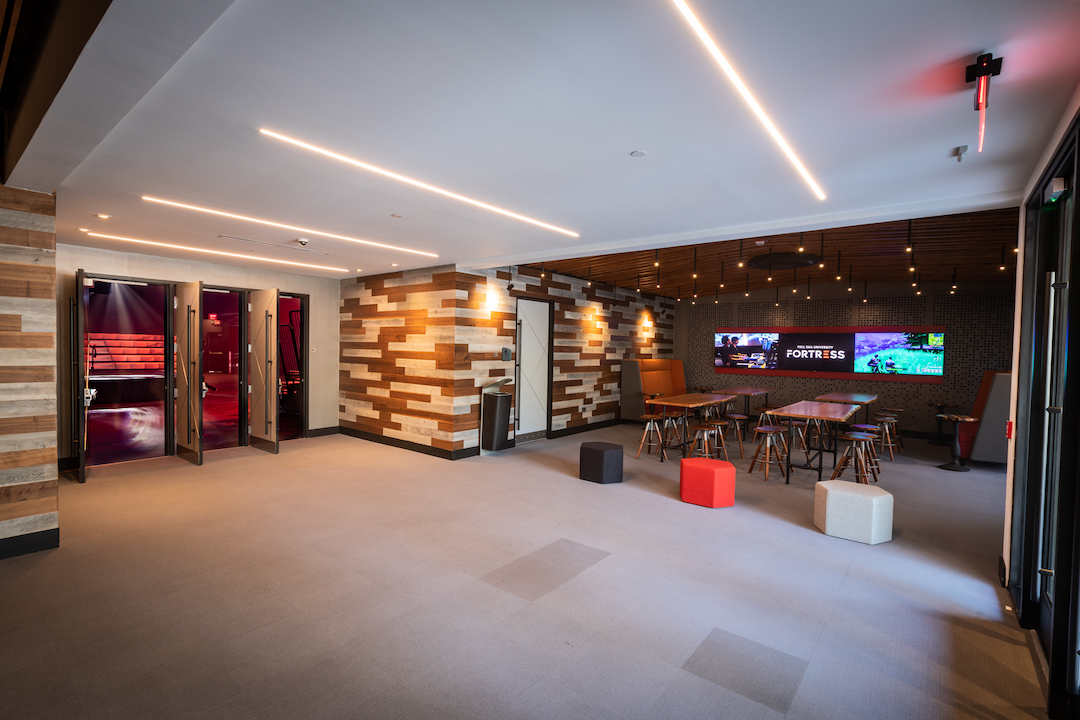 The Fortress lobby space welcomes spectators into the arena before ushering them into the main gaming and viewing space. Photo courtesy Full Sail University.
The Fortress lobby space welcomes spectators into the arena before ushering them into the main gaming and viewing space. Photo courtesy Full Sail University.
Additionally, the campus’s aesthetic had to be taken into account. “The Fortress at Full Sail University was created as a continuation of the fluid campus design allowing seamless spaces to merge throughout the campus,” Posada said.
To date, The Fortress has hosted varied events such as Call of Duty tournaments; Red Bull’s regional fighting game series, Conquest; and the Hearthstone collegiate championship finals.
Division 1 eSports arenas: Is Goliath preparing a counterattack?
While smaller universities are currently the vanguard for collegiate eSports venues, it may just be a matter of time before larger schools join the party.
Although they haven’t quite committed to the same level as smaller schools, D-I schools such as Ohio State University, Penn State, and Georgia Tech all have eSports teams that are actively competing in tournaments. Ohio State has even opened its own version of an eSports Arena with 80 gaming computers, consoles, and virtual reality systems; a room for competitive gaming with peer universities; and a broadcast booth.
Although the space is less “arena” and more “computer lab,” it is still a sign that D-I schools are taking eSports seriously. And while there isn’t the eSports equivalent of Duke’s Cameron Indoor Stadium or USC’s Coliseum yet, “yet” may be the key word in this equation.
See Also: With a new type of stadium comes a new type of premium seat
“Larger universities that have heavy technology majors are getting involved, but the majority have clubs within their student life or activities departments and are not yet embracing the incorporation of eSports into their athletic programs,” Dubbs said. “However, with the revenue for eSports approaching $1.5 billion, I believe larger universities will eventually become involved because the potential for increasing their revenue stream will be too tempting to ignore.”
For now, the David’s of the college landscape (HU, Full Sail University) are leading the eSports charge, but it won’t be long until a Goliath comes along and builds a university eSports arena to rival even the leading commercial facilities in the world. With revenue in the billions, it’s less a matter of “if,” and more a matter of “when.”
Related Stories
Sports and Recreational Facilities | Oct 24, 2024
Stadium renovation plans unveiled for Boston’s National Women’s Soccer League
A city-owned 75-year-old stadium in Boston’s historic Franklin Park will be renovated for a new National Women’s Soccer League team. The park, designed by Fredrick Law Olmsted in the 1880s, is the home of White Stadium, which was built in 1949 and has since fallen into disrepair.
Sports and Recreational Facilities | Oct 17, 2024
In the NIL era, colleges and universities are stepping up their sports facilities game
NIL policies have raised expectations among student-athletes about the quality of sports training and performing facilities, in ways that present new opportunities for AEC firms.
Designers | Oct 1, 2024
Global entertainment design firm WATG acquires SOSH Architects
Entertainment design firm WATG has acquired SOSH Architects, an interior design and planning firm based in Atlantic City, N.J.
Products and Materials | Aug 31, 2024
Top building products for August 2024
BD+C Editors break down August's top 15 building products, from waterproof wall panel systems to portable indoor pickleball surface solutions.
Designers | Jul 29, 2024
Inclusive design for locker rooms: Providing equitable choice and access
SRG designers pose the question: What would it look like if everyone who wanted to use a restroom or locker room could?
Great Solutions | Jul 23, 2024
41 Great Solutions for architects, engineers, and contractors
AI ChatBots, ambient computing, floating MRIs, low-carbon cement, sunshine on demand, next-generation top-down construction. These and 35 other innovations make up our 2024 Great Solutions Report, which highlights fresh ideas and innovations from leading architecture, engineering, and construction firms.
Sports and Recreational Facilities | Jul 15, 2024
Smart stadiums: The future of sports and entertainment venues
These digitally-enhanced and connected spaces are designed to revolutionize the fan experience, enhance safety, and optimize operational efficiency, according to SSR's Will Maxwell, Smart Building Consultant.
Sports and Recreational Facilities | May 23, 2024
The Cincinnati Open will undergo a campus-wide renovation ahead of the expanded 2025 tournament
One of the longest-running tennis tournaments in the country, the Cincinnati Open will add a 2,000-seat stadium, new courts and player center, and more greenspace to create a park-like atmosphere.
Sports and Recreational Facilities | Apr 25, 2024
How pools can positively affect communities
Clark Nexsen senior architects Jennifer Heintz and Dorothea Schulz discuss how pools can create jobs, break down barriers, and create opportunities within communities.
Mixed-Use | Apr 9, 2024
A surging master-planned community in Utah gets its own entertainment district
Since its construction began two decades ago, Daybreak, the 4,100-acre master-planned community in South Jordan, Utah, has been a catalyst and model for regional growth. The latest addition is a 200-acre mixed-use entertainment district that will serve as a walkable and bikeable neighborhood within the community, anchored by a minor-league baseball park and a cinema/entertainment complex.


